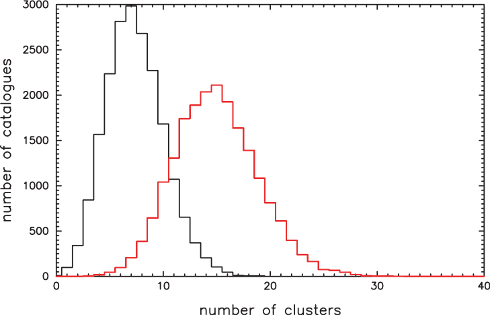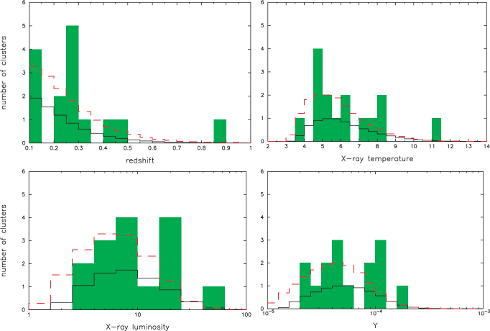 CAUP Researchers: Pedro T. P. Viana, António C. da Silva, Elsa P. R. G. Ramos The XMM Cluster Survey: Predicted overlap with the Planck Cluster Catalogue, We present a list of 15 clusters of galaxies, serendipitously detected by the XMM Cluster Survey (XCS), that have a high probability of detection by the Planck Surveyor satellite. Three of them already appear in the Planck Early Sunyaev–Zel’dovich (ESZ) catalogue. The estimation of the Planck detection probability assumes the flat ΛCDM cosmology most compatible with WMAP-7 data. It takes into account the XCS selection function and Planck sensitivity, as well as the covariance of the cluster X-ray luminosity, temperature, and integrated comptonization parameter, as a function of cluster mass and redshift, determined by the Millennium Gas Simulations. We also characterise the properties of the galaxy clusters in the final data release of the XCS that we expect Planck will have detected by the end of its extended mission. Finally, we briefly discuss possible joint applications of the XCS and Planck data. The study of the intracluster medium within galaxy clusters started with the use of X-ray data, through the bremsstrahlung effect and the gas emission lines, but has recently been expanded with the use of the Sunyaev–Zel’dovich effect in the sub-millimeter/millimeter wavelengths. Data from both these sources is complementary and its combined use allows, for example, the determination of the angular-diameter distance, thus having major implications for cosmology. Nevertheless, until now, only a small number of galaxy clusters have been observed both in X-ray and radio bands, but a number of surveys are currently underway and are expected to yield large catalogues of galaxy clusters. Among these, for the large number of clusters they are expected to detect, two surveys stand out: the XMM Cluster Survey (X-ray) and the Planck Cluster Survey (sub-millimeter/millimeter). The paper here highlighted determined which clusters detected by the XMM survey were more likely to also be detected by the Planck survey, as well as the distribution of the properties of clusters which are likely to be detected in both surveys. The XMM Cluster Survey is based on automatic identification of cluster candidates in publicly available data from XMM-Newton pointings. These candidates are then confirmed using X-ray and optical data, with X-ray spectroscopy being performed in the confirmed galaxy clusters, as well as a determination of their X-ray temperatures, if enough photon counts are available. This survey, still ongoing, has already 503 confirmed clusters and covers 410 deg2 of sky. By the end of this effort, data of over 600 deg2 of sky will have been analyzed and several thousand clusters are expected to make its way into this catalogue, about 20% of which will have their X-ray temperature determined. On the other hand, the Planck Cluster Survey is based on data collected by the Planck satellite and, by the end of this nominal mission, is expected to contain about 2000 galaxy clusters. The first available version of this catalogue, the Planck Early Sunyaev–Zel’dovich catalogue, comprises 189 clusters. In the work leading to the publication of this paper, the team used results from the Millennium Gas Simulation and the technical data regarding Planck detection limits in order to determine Planck’s probability of detection of a given cluster. The cosmological model – also needed to determine such probabilities – was assumed to be the one derived from the 7-year Wilkinson Microwave Anisotropy Probe results. Finally, the knowledge of the XMM Cluster Survey selection function, as well as some assumptions made about the galaxy cluster populations were also used in order to refine the determination of the expected overlap between the two surveys. The probability of detection was only computed for clusters with over 250 photon counts, in order to allow the determination of the cluster observable quantities with a reasonably low uncertainty. Furthermore, as the XMM Cluster Survey sensitivity function has only been determined for galaxy clusters with redshift 0.1 < z < 1.0 and an X-ray temperature over 2 keV, only clusters within these ranges were considered. This yielded a list of 15 clusters with a probability of detection higher than 0.5, three of which are already present in the Planck Early Sunyaev–Zel’dovich catalogue. These 15 clusters are among the closest, most luminous and hotter galaxy clusters present in the X-ray catalogue.
Afterwards, 20.000 random mock catalogues were generated and tested in order to determine the distribution of probability for the number of clusters detected by both surveys. The results, depicted in Fig. 1, show that one should expect the detection of 7 clusters with the nominal Planck mission and a total of 15 clusters, when the extended mission is considered. We note, however, that these results are strongly dependent in the assumptions made for the cosmological model. In Fig. 2 we represented the mean distributions of the properties of the galaxy clusters that appear in the 20.000 random mock catalogues of the expected overlap between the XCS and Planck Cluster Survey, both for the nominal and extended missions.
Furthermore, the results from the simulations performed also lowered the number of clusters expected to be detected by Planck to about 630 at the end of the nominal mission and around 1300 at the end of the extended mission, contrasting with the ~2000 previously expected. Thus, our work suggests that the data which will be available at the end of both the XMM-Newton and Planck cluster surveys, although being very important in providing insights into the relation between properties determined with X-ray and sub-millimeter/millimetre wavelengths, will not be enough to fully determine these relations. The main contribution of CAUP to the work presented here was the estimation of the Planck detection probabilities for the clusters in the current XCS catalogue, and the generation of the 20.000 random mock catalogues used to determine the probability distribution for the number of clusters detected by both surveys, as well as their average properties. |























